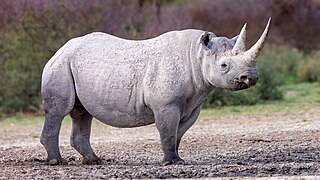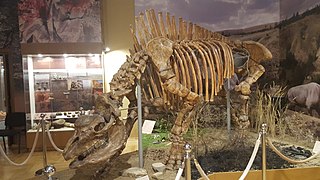
Perissodactyla is an order of ungulates. The order includes about 17 living species divided into three families: Equidae, Rhinocerotidae (rhinoceroses), and Tapiridae (tapirs). They typically have reduced the weight-bearing toes to three or one of the five original toes, though tapirs retain four toes on their front feet. The nonweight-bearing toes are either present, absent, vestigial, or positioned posteriorly. By contrast, artiodactyls bear most of their weight equally on four or two of the five toes: their third and fourth toes. Another difference between the two is that perissodactyls digest plant cellulose in their intestines, rather than in one or more stomach chambers as artiodactyls, with the exception of Suina, do.

The black rhinoceros is a species of rhinoceros, native to eastern Africa and southern Africa, including Angola, Botswana, Kenya, Malawi, Mozambique, Namibia, South Africa, Eswatini, Tanzania, Zambia, and Zimbabwe. Although the species is referred to as black, its colours vary from brown to grey. It is the only extant species of the genus Diceros.

Elasmotherium is an extinct genus of large rhinoceros endemic to Eastern Europe and Central Asia with isolated finds from East Asia during Late Miocene through to the Late Pleistocene, with the youngest reliable dates around 39,000 years ago. It was the last surviving member of Elasmotheriinae, a distinctive group of rhinoceroses separate from the group that contains living rhinoceros (Rhinocerotinae).

A rhinoceros, commonly abbreviated to rhino, is a member of any of the five extant species of odd-toed ungulates in the family Rhinocerotidae; it can also refer to a member of any of the extinct species of the superfamily Rhinocerotoidea. Two of the extant species are native to Africa, and three to South and Southeast Asia.

Diceros is a genus of rhinoceros containing the extant black rhinoceros (Diceros bicornis) and several extinct species.

Dicerorhinus is a genus of the family Rhinocerotidae, consisting of a single extant species, the two-horned Sumatran rhinoceros, and several extinct species. The genus likely originated from the Late Miocene of central Myanmar. Many species previously placed in this genus probably belong elsewhere.

The white rhinoceros, white rhino or square-lipped rhinoceros is the largest extant species of rhinoceros. It has a wide mouth used for grazing and is the most social of all rhino species. The white rhinoceros consists of two subspecies: the southern white rhinoceros, with an estimated 16,803 wild-living animals, and the much rarer northern white rhinoceros. The northern subspecies has very few remaining individuals, with only two confirmed left in 2018. Sudan, the world's last known male northern white rhinoceros, died in Kenya on 19 March 2018 at age 45.

Rhinoceros is a genus comprising one-horned rhinoceroses. This scientific name was proposed by Swedish taxonomist Carl Linnaeus in 1758. The genus contains two species, the Indian rhinoceros and the Javan rhinoceros. Although both members are threatened, the Javan rhinoceros is one of the most endangered large mammals in the world with only 60 individuals surviving in Java (Indonesia). The word 'rhinoceros' is of Greek origin meaning "nose-horn".

Ancylotherium is an extinct genus of the family Chalicotheriidae, subfamily Schizotheriinae, endemic to Europe, Asia, and Africa during the Late Miocene-Early Pleistocene, existing for approximately 9.8 million years.

Sinotherium is an extinct genus of single-horned elasmotheriine rhinocerotids that lived from the late Miocene to Early Pliocene. It was ancestral to Elasmotherium, demonstrating a very important evolutionary transition from nasal-horned elasmotheriines to frontal-horned elasmotheriines. Its fossils have been found in the Karabulak Formation of Kazakhstan, lower jaw and teeth have been found in Mongolia, and a partial skull is known from the upper part of the Liushu Formation of western China. Sinotherium diverged from the ancestral genus, Iranotherium, first found in Iran, during the early Pliocene. Some experts prefer to lump Sinotherium, and Iranotherium into Elasmotherium.

Chilotherium is an extinct genus of rhinocerotids endemic to Eurasia during the Miocene through Pliocene living for 13.7—3.4 mya, existing for approximately 10.3 million years.
Ceratotherium mauritanicum is a species of fossil African rhinoceros found in the Late Pliocene to early Late Pleistocene of Morocco, Tunisia, and Algeria. It is disputed as to whether remains from the Pliocene of East Africa belong to this species, and if so, whether C. mauritanicum is ancestral to the modern white rhinoceros. During the early Late Pleistocene, sometime between 120,000–57,000 years ago, it was replaced in North Africa by the modern white rhinoceros.

Ceratotherium neumayri is a fossil species of rhinoceros from the Late Miocene (Vallesian-Turolian) of the Balkans and Western Asia, with remains known from Greece, Bulgaria, Iran, and Anatolia in Turkey.
Paracamelus is an extinct genus of camel in the family Camelidae. It originated in North America Around 8-7 Ma, and crossed the Beringian land bridge into Eurasia during the Late Miocene, about 6 million years ago (Ma). It is the presumed ancestor to living camels of the genus Camelus.

Stephanorhinus is an extinct genus of two-horned rhinoceros native to Eurasia and North Africa that lived during the Late Pliocene to Late Pleistocene. Species of Stephanorhinus were the predominant and often only species of rhinoceros in much of temperate Eurasia, especially Europe, for most of the Pleistocene. The last two species of Stephanorhinus – Merck's rhinoceros and the narrow-nosed rhinoceros – went extinct during the last glacial period.

Brachypotherium is an extinct genus of rhinocerotid that lived in Eurasia and Africa during the Miocene.

The narrow-nosed rhinoceros, also known as the steppe rhinoceros is an extinct species of rhinoceros belonging to the genus Stephanorhinus that lived in western Eurasia, including Europe, as well as North Africa during the Pleistocene. It first appeared in Europe around 500,000 years ago during the Middle Pleistocene and survived there until at least 34,000 years Before Present. It was native to temperate and Mediterranean environments, where it fed on low growing plants and to a lesser extent woody plants. Evidence has been found that it was exploited for food by archaic humans, including Neanderthals.
Diceros praecox is an extinct species of rhinoceros that lived in Africa during the Pliocene, around 4 million years ago. It has been suggested to be the direct ancestor of the living black rhinoceros (Diceros bicornis).

Dihoplus is an extinct genus of rhinoceros that lived in Eurasia from the Late Miocene to Pliocene.

Pliorhinus is an extinct genus of rhinoceros known from the Late Miocene and Pliocene of Eurasia. The type species, Pliorhinus megarhinus, was previously assigned to Dihoplus.


























